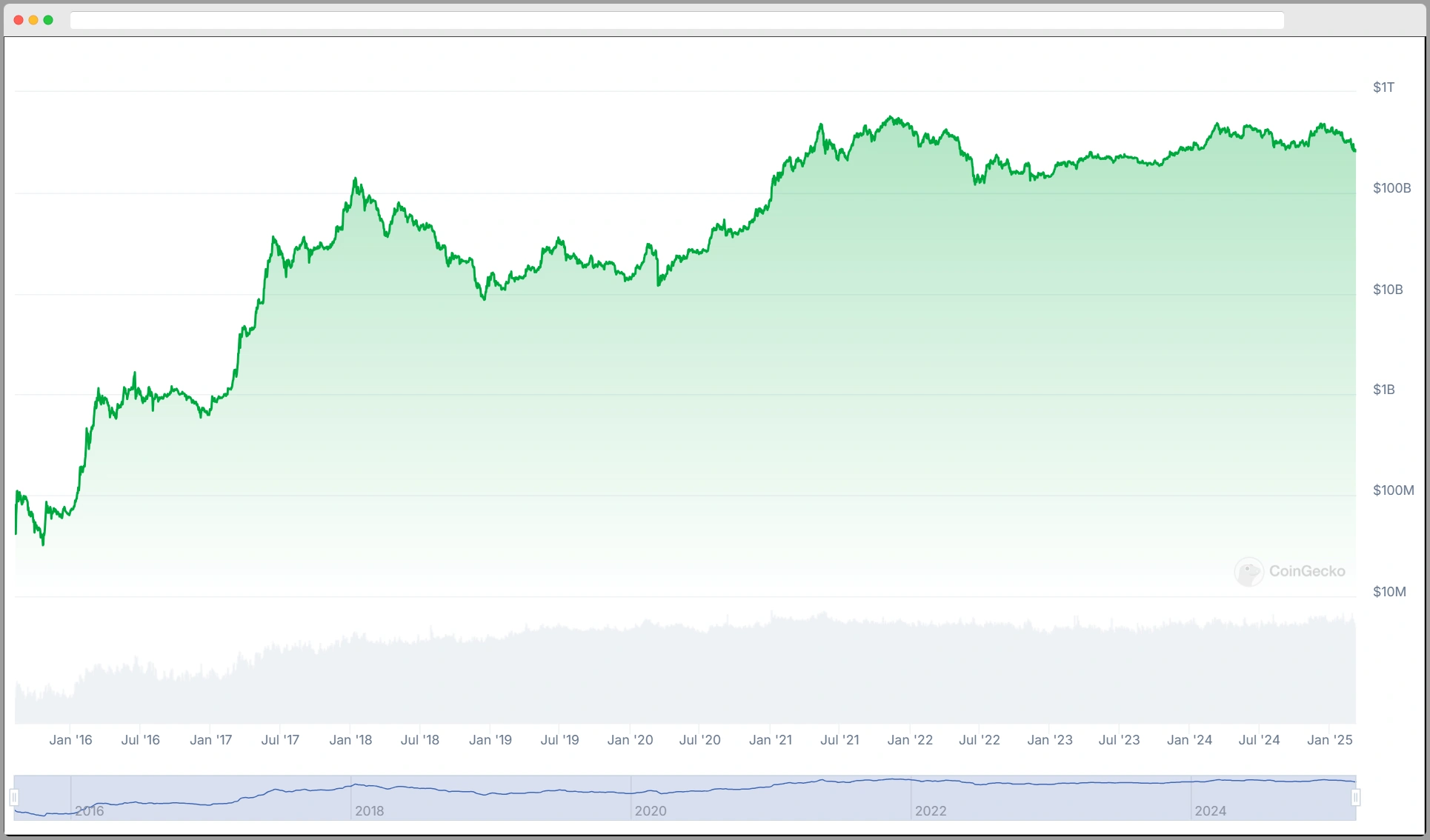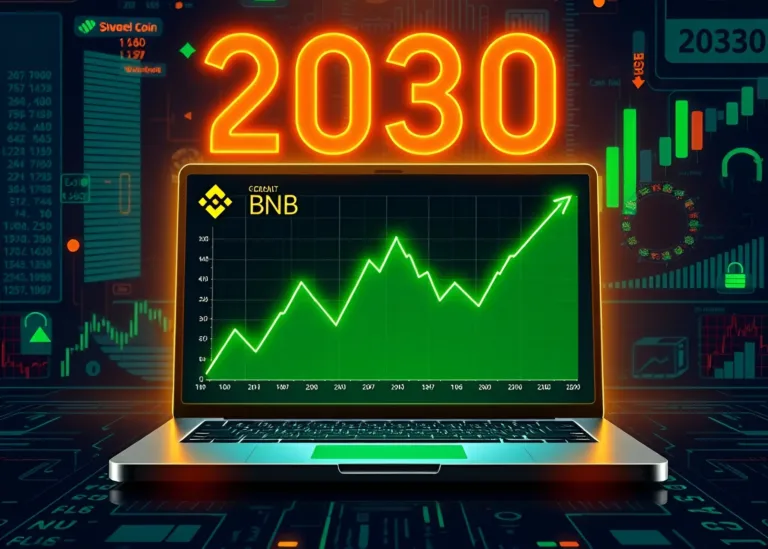How Much Will Ethereum Be Worth in 2040?
Ethereum’s value by 2040 is projected to considerably exceed current levels. Analysts estimate it could surpass $10,000 per ETH, fueled by growing institutional adoption and diverse use cases.
Some experts are optimistic about ETH’s future, citing improvements in scalability and transaction efficiency.
Others, view competition from other crypto assets as a potential risk. This article breaks down how these factors could impact ETH’s price trajectory.
Key Takeaways:
Hide- Bearish Scenario: Conservative models suggest Ethereum could be around $5,000 (or low-to-mid four figures) if growth stalls due to technical or regulatory setbacks. (Source: CoinCodex)
- Neutral Scenario: In a steady-growth scenario, Ethereum could reach between $30,000 and $40,000, reflecting continued but moderate adoption. (Source: CoinCodex and Telegaon)
- Bullish Scenario: If Ethereum becomes a cornerstone of global finance and digital infrastructure, its price could soar into the $50,000 to $100,000 range—or even higher. (Source: CoinGabbar)
Historical Price Trends of Ethereum

Although Ethereum’s price has exhibited significant volatility since its inception in 2015, a thorough analysis reveals distinct patterns that underscore its growth trajectory.
Initially valued at approximately $0.30, Ethereum surged to over $1,400 by early 2018, reflecting a robust demand for its smart contract functionality.
Post-2018, the price experienced substantial retracements, with a notable low of around $100 in late 2018.
However, the subsequent bull run in 2020, driven by decentralized finance (DeFi) and non-fungible tokens (NFTs), propelled its price to new heights, surpassing $4,800 in late 2021.
This historical context indicates that Ethereum’s value is influenced by tech adoption, sentiment, and broader economic conditions, suggesting potential for future price appreciation as innovations continue.
Technological Advancements and Their Impact

The evolution of Layer 2 solutions has markedly enhanced Ethereum’s scalability, addressing critical transaction speed and cost challenges.
Concurrently, innovations in decentralized finance (DeFi) are reshaping traditional financial paradigms, enabling new economic models and user engagement strategies.
Together, these technological advancements are poised to redefine Ethereum’s value proposition and market position by 2040.
Layer 2 Solutions
As Ethereum continues to evolve, Layer 2 solutions have emerged as essential technological advancements that promise to enhance scalability and reduce transaction costs.
These solutions, including Optimistic Rollups and zk-Rollups, allow for off-chain processing, considerably increasing transaction throughput while minimizing congestion on the main Ethereum blockchain.
Analysis indicates that by 2040, the implementation of these technologies could enable Ethereum to handle millions of transactions per second, positioning it as a leading platform for decentralized applications.
Furthermore, reduced gas fees could democratize access, fostering broader adoption across industries.
As developers innovate these solutions, their impact on Ethereum’s ecosystem will be profound, potentially driving considerable market valuation and establishing Ethereum as a cornerstone of the blockchain landscape.
Decentralized Finance Innovations
While the growth of Decentralized Finance (DeFi) has been remarkable, ongoing technological advancements are set to further revolutionize financial services by 2040.
Innovations such as automated market makers (AMMs), yield farming, and synthetic assets are transforming traditional financial paradigms.
By integrating artificial intelligence and machine learning, DeFi platforms are enhancing risk management and user experience, enabling personalized financial products.
The rise of cross-chain interoperability is predicted to foster a more inclusive ecosystem, allowing seamless asset transfers across networks.
Additionally, decentralized identity solutions are likely to enhance security and privacy, attracting a broader user base.
As these technologies mature, they will not only disrupt existing financial systems but also pave the way for a new era of transparent, efficient, and accessible financial services.
Adoption Rates Across Industries
The adoption rates of Ethereum across various industries are influenced by specific use cases that demonstrate its utility and effectiveness.
Regulatory frameworks play an essential role in shaping these rates, as compliance can either facilitate or hinder integration into established systems.
Additionally, the scalability and performance challenges faced by Ethereum networks can greatly impact industry-wide uptake, determining the extent to which businesses can leverage its capabilities.
Industry-Specific Use Cases
Numerous industries are increasingly recognizing the potential of Ethereum as a foundational technology for various applications, driving adoption rates that reflect its versatility.
In finance, decentralized finance (DeFi) platforms leverage Ethereum’s smart contracts to streamline transactions, reducing costs and improving accessibility.
Supply chain management benefits from Ethereum’s transparency, enabling real-time tracking and verification of goods, consequently enhancing efficiency and trust.
The healthcare sector utilizes Ethereum for secure patient data management, ensuring privacy while facilitating interoperability among systems.
Additionally, the gaming industry is exploring non-fungible tokens (NFTs) on Ethereum to create unique digital assets, revolutionizing ownership.
These industry-specific use cases illustrate Ethereum’s capacity to transform traditional processes, positioning it as a pivotal player in the future of various sectors.
Regulatory Impact Analysis
As regulatory frameworks evolve, their influence on Ethereum’s adoption rates across various industries becomes increasingly evident.
Policymakers are gradually recognizing the potential of blockchain technology, leading to more structured environments that encourage innovation while ensuring consumer protection.
Industries such as finance, healthcare, and supply chain are witnessing heightened interest in Ethereum’s capabilities, driven by regulatory clarity.
For instance, financial institutions are exploring decentralized finance (DeFi) solutions under new guidelines, while healthcare is leveraging smart contracts to enhance data security and interoperability.
Furthermore, compliance with regulations can enhance trust, attracting larger institutional players.
Consequently, as regulations become more supportive, the adoption rates of Ethereum are likely to accelerate, positioning it as a foundational technology for diverse sectors by 2040.
Scalability and Performance Challenges
Scalability and performance challenges represent significant hurdles for Ethereum’s widespread adoption across various industries.
Despite its potential, Ethereum’s current transaction throughput remains limited, averaging around 30 transactions per second, which pales in comparison to traditional payment systems like Visa, capable of handling thousands per second.
As industries increasingly explore blockchain solutions, the bottleneck in transaction speeds and high gas fees can hinder operational efficiency and user experience.
Moreover, as decentralized applications proliferate, the network’s congestion may lead to slower processing times, deterring prospective users.
Innovations such as layer-2 solutions and sharding are being developed to address these issues, yet their implementation and effectiveness will play an essential role in determining Ethereum’s viability as a foundational technology in the coming years.
Regulatory Environment and Its Influence
While the future of Ethereum hinges not only on technological advancements but also on the regulatory landscape, the interplay between government policies and cryptocurrency markets is becoming increasingly essential.
As Ethereum evolves, three regulatory factors will likely shape its trajectory:
- Taxation Policies: Clear frameworks could either incentivize or deter investment.
- Compliance Standards: Stricter regulations may enhance security but could stifle innovation and accessibility.
- Global Regulatory Coordination: Harmonization across jurisdictions will be crucial for fostering international investment and user confidence.
The regulatory environment will serve as both a safeguard and a potential barrier, influencing market dynamics and innovation.
Stakeholders must navigate this complex landscape to leverage opportunities while ensuring compliance, ultimately shaping Ethereum’s value by 2040.
Market Dynamics and Economic Factors
Market dynamics and economic factors will play a pivotal role in shaping Ethereum’s valuation by 2040.
As the demand for decentralized applications (dApps) increases, Ethereum’s network effects may amplify, driving higher transaction volumes and consequently, its value.
The evolution of layer-2 solutions could enhance scalability, thereby attracting more developers and users to the platform.
In addition, global economic conditions, such as inflation rates and investment trends in digital assets, will influence Ethereum’s attractiveness as a store of value.
Competing blockchain technologies may also impact Ethereum’s market share, necessitating continuous innovation to maintain its leadership.
Ultimately, the interplay between supply constraints, technological advancements, and market sentiment will be critical in determining Ethereum’s future worth.
Comparison With Other Cryptocurrencies

A thorough analysis of Ethereum’s positioning within the cryptocurrency landscape reveals significant competitive dynamics that will shape its future valuation.
As the second-largest cryptocurrency by market capitalization, Ethereum faces challenges and opportunities from several key competitors.
- Bitcoin: Known as digital gold, BTC maintains a stronghold as a value store, often overshadowing Ethereum’s utility focus.
- Cardano: With a research-driven approach, ADA poses a direct challenge to Ethereum’s dominance in smart contracts and decentralized applications.
- Solana: Its high throughput and low transaction costs present a compelling alternative, SOL attracting developers and users seeking efficiency.
Ethereum must navigate these competitive waters while continuously innovating to sustain its market position and capitalize on emerging trends.
Predictions From Industry Experts
Ethereum’s long-term price predictions vary widely because of many unknown factors. Analysts emphasize that forecasting so far ahead is highly speculative, but considering different scenarios can be helpful:
Bearish Scenario:
If Ethereum faces major setbacks, such as technical failures, strict regulations, or heavy competition, its growth could stall.
In a low-growth environment (e.g., 5% annual growth), estimates suggest prices around $5,000 by 2040.
In a worse case, if Ethereum loses relevance, prices could fall even further, remaining in the low-to-mid four-figure range relative to today’s value.
Neutral/Base Scenario:
In a steady-growth scenario, Ethereum continues to expand its user base and usage without dramatic breakthroughs or failures.
Under these balanced conditions, many forecasts place Ethereum between $30,000 and $40,000 by 2040.
This assumes Ethereum remains a key platform for decentralized applications while facing normal competitive pressures.
Bullish Scenario:
If Ethereum overcomes its challenges and achieves mass adoption, becoming essential for finance, supply chains, digital identity, and more, demand for ETH could skyrocket.Optimistic forecasts suggest prices could reach between $50,000 and $100,000 or even higher, with some extreme projections predicting prices in the hundreds of thousands.
All in all, almost all experts agree that Ethereum’s 2040 price will largely depend on how widely it is adopted in the real world.
Potential Use Cases of Ethereum in 2040
How might Ethereum transform various sectors by 2040? As the blockchain landscape evolves, Ethereum’s capabilities could lead to groundbreaking applications across multiple industries.
The potential use cases are vast and varied, including:
- Decentralized Finance (DeFi): Streamlining financial services through automated, trustless transactions, reducing reliance on traditional banks.
- Supply Chain Management: Enhancing transparency and traceability, allowing for real-time tracking of goods and reducing fraud.
- Digital Identity Verification: Providing individuals with secure, self-sovereign identities that can be used to access services without compromising privacy.
Risks and Challenges Ahead
The potential of Ethereum to revolutionize various industries is tempered by a range of risks and challenges that could hinder its widespread adoption by 2040.
Regulatory uncertainty remains a significant concern, as governments worldwide grapple with how to classify and govern cryptocurrencies.
Regulatory uncertainty poses a major challenge as global governments navigate the complexities of cryptocurrency classification and governance.
Additionally, the scalability issues inherent in Ethereum’s current architecture may limit its ability to handle increased transaction volumes, especially as decentralized applications gain traction.
Competition from emerging blockchain technologies could also pose a threat, potentially leading to fragmentation within the ecosystem.
Moreover, security vulnerabilities, including smart contract exploits, could undermine user trust.
Addressing these challenges will require concerted efforts from developers, stakeholders, and regulators to guarantee Ethereum’s resilience and long-term viability in a rapidly evolving digital landscape.
Wrapping Up
In summation, speculating on Ethereum’s future value in 2040 requires a careful consideration of fluctuating factors.
If Ethereum encounters significant hurdles like technical setbacks or stringent regulations, a bearish scenario could see it trading around $5,000 by 2040.
In a balanced, steady-growth environment, its price might settle between $30,000 and $40,000, reflecting continued adoption and network utility.
Conversely, if Ethereum overcomes its challenges and becomes a fundamental part of global finance and digital infrastructure, a bullish scenario could push its value into the $50,000 to $100,000 range—or even higher.
Finally, Ethereum’s evolution hinges on its ability to navigate these dynamic dimensions, potentially positioning it as a prominent player in the digital economy landscape of the future.






